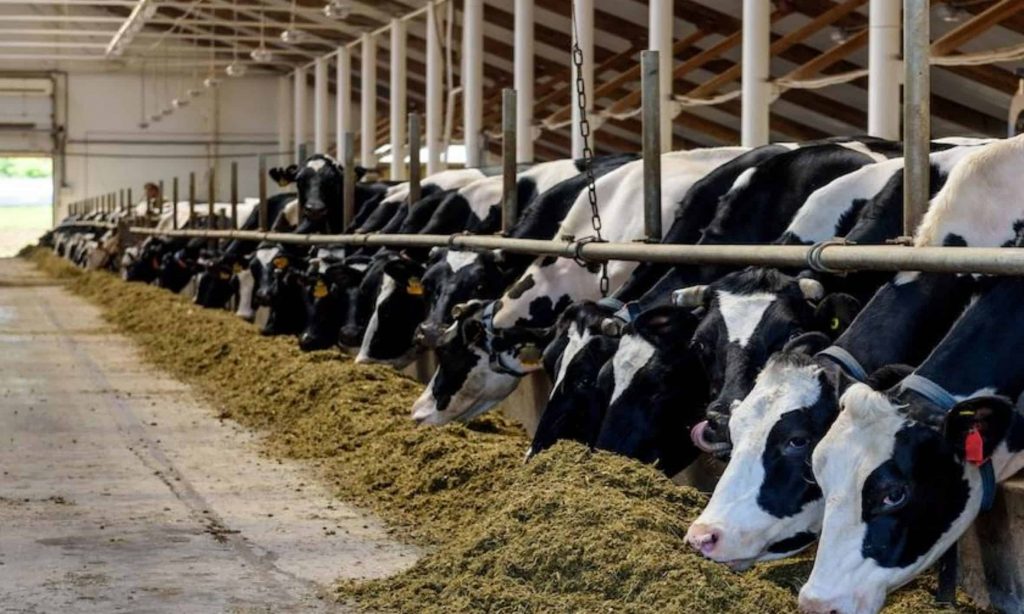
The downturn in U.S. milk production was bigger than we thought, but is likely over.
The Agriculture Department’s preliminary data put September output at 18.210 billion pounds, down a somewhat bullish 32 million pounds or 0.2% from Sept. 2022.
The top 24-State total, at 17.465 billion, was down 0.03%. It was the third consecutive month output lagged a year ago as low milk prices and high feed costs took their toll.
The 24 state revision was down 73 million pounds, down 0.7%, instead of a 0.3% loss.
The Oct. 19 Daily Dairy Report stated that “USDA made important revisions to data in prior months, suggesting that since April, milk supplies have been lighter than previously believed. USDA revised lower year-over-year production for each of the last five months by at least 0.1%.”
September cow numbers totaled 9.370 million head, down 6,000 from the August count, which was revised down 14,000 head. The herd is 36,000 below a year ago and the smallest since Jan. 2022.
The 24-State count was down 2,000 from August, which was revised up 1,000 head, but is 16,000 below a year ago.
Output per cow in the 50 states averaged 1,943 pounds, down 68 pounds from August, but 4 pounds or 0.2% above Sept. 2022. The 24-State output averaged 1,960 pounds, down 70 from August but 3 pounds or 0.15% above a year ago. Revisions lowered August output by 10 pounds in the 50 states and lowered it 8 pounds in the 24 States.
California cows put 3.2 billion pounds in the tank, down 60 million or 3.7% from a year ago. Cow numbers were down 9,000 and output per cow was down 25 pounds. California hasn’t posted a gain since August 2022.
Wisconsin, with 2.6 billion pounds produced, was up 30 million or 1.1% from a year ago, thanks to a 25-pound gain per cow offsetting the loss of 1,000 cows.
Idaho was off 0.6%, on a 30-pound drop per cow, though cow numbers were up 5,000.
Michigan was up 2.7%, Minnesota was off 0.6%, New Mexico was down 7.2%, and New York was up 2.0%.
Oregon was down 4.2% on a loss of 5,000 cows. Output per cow was unchanged. Pennsylvania was off 0.1%, while South Dakota was up 5.9%.
Texas was down 1.0%, despite a 45-pound gain per cow. Cow numbers, still hurting from the fire, were down 20,000.
Washington state was down 1.2%, on a 20-pound drop per cow. Cow numbers were unchanged from a year ago.
Slowed culling
Dairy culling continues to slow. The latest Livestock Slaughter report showed an estimated 240,500 head sent to slaughter under federal inspection in September, down 34,700 head from August, and 20,000 or 7.7% below September 2022.
The week ending Oct. 7 saw 57,100 dairy cows culled, up 500 from the previous week but 2,900 or 4.8% below a year ago. Year to date 2,435,200 head have been “retired,” up 93,900 or 4.0% from a year ago.
Class I up 28 cents
The November Federal order Class I base milk price was announced at $19.75 per hundredweight, up 28 cents from October, $4.34 below November 2022, and the highest Class I since February. It equates to $1.70 per gallon, down from $2.07 a year ago. The eleven average stands at $19.15, down from $23.76 a year ago, and compares to $16.61 in 2021.
Fluid sales down 1.8%
Fluid milk sales remain on a slide. The latest data shows August packaged sales at 3.6 billion pounds, down 1.8% from August 2022. Conventional product sales totaled 3.3 billion pounds, down 2.1% from a year ago, while organic products, at 247 million pounds, were up 2.5%.
Whole milk sales totaled 1.3 billion pounds, up 1.6% from a year ago, up 1.3% year to date, and represented 35.3% of total sales in the eight-month period.
Skim milk sales, at 168 million pounds, were down 9.5% from a year ago and down 7.8% year to date.
Total packaged fluid sales January to August hit 25.8 billion pounds, down 1.9% from 2022. Conventional product sales totaled 26.1 billion pounds, down 2.0%. Organic products, at 1.9 billion pounds, were down 1.1%, and represented a pretty normal 6.7% of total milk sales for the period.
Cheese disappearance down
USDA’s August Dairy Product Supply and Utilization data shows total cheese utilization at 1.19 billion pounds, down 3.1% from August 2022, largest decline since April 2020, according to HighGround Dairy, primarily driven by a 4.6% drop in domestic American consumption and exports being down 16.1%
Butter usage, at 189 million pounds, was up 0.2%, thanks to strong domestic demand overcoming a 62.9% plunge in exports.
Nonfat-skim milk powder, at 189.6 million pounds, was down 14.2%, lowest monthly level since January 2020, says HGD, “as domestic demand plummeted 49.1%, lowest August volume on record with data back to 2011,” while exports were up 4.3%.
Dry whey consumption hit 82.2 million pounds, up 2.4%, thanks to a 71.1% increase in domestic use offsetting a 38.2% loss in exports. However, on a month-to-month basis, HGD says domestic usage declined while exports rose for the first time since March.
Prices shaky
CME block Cheddar climbed to $1.8125 per pound last Thursday, highest since Sept. 19, but closed Friday at $1.7875, up 8.75 cents on the week, ending six weeks of losses but still 27 cents below a year ago.
The barrels finished Friday at $1.71, 6.50 cents higher, highest since Sept. 18, 38 cents below a year ago, and 7.75 cents below the blocks; 29 loads of block were traded last week and 15 of barrel.
The blocks lost 2.25 cents Monday on 5 trades and were offered 2.25 cents lower Tuesday, dipping to $1.7425, as traders awaited Wednesday’s September Cold Storage report.
The barrels were up 2.50 cents Monday on 3 trades and stayed put Tuesday at $1.7350.
Dairy Market News reports that some Cheddar and pizza style cheesemakers say orders are below average for this time of year. Others are as busy, if not busier. Cheese inventories have grown at some plants but not to a concerning level. One reason is the milk supply which is still in line with previous weeks. Reported spot prices ranged from 25 cents to $1.75 over Class III. Last year, they were $3 under to $1 over Class.
Cheese demand in the west is steady from retail and food service. Exports lag domestic demand, though sentiment is that that prices are more competitive to attract interest from international buyers.
Spot butter, after plunging 14.25 cents the previous week, fell to $3.35 per pound last Monday, then jumped 6 cents Tuesday, only to close Friday at $3.36, unchanged on the week and 16 cents above a year ago, with 13 loads trading hands.
The butter was up 1.50 cents Monday, with 3 loads exchanging hands, then gave back a penny Tuesday on 3 sales, slipping to $3.3650.
Cream has been somewhat tight until October, according to DMN, but butter makers said it opened up late last week and over the weekend. Cream spots are now in the low 1.20s, “within the fiscal comfort zone for churning.”
Cream is tight in the West, but spot loads are available. Some butter producers are limiting purchases of cream due to current prices. Domestic demand for butter is reported as steady.
Grade A nonfat dry milk climbed to $1.2350 per pound last Thursday but finished Friday at $1.2325, up 1.25 cents on the week but still 18.75 cents below a year ago. There were 18 sales on the week.
Monday’s powder was up 0.75 cents on 4 loads traded, hitting $1.24, highest since Feb. 13, but then slid 2 cents Tuesday, to $1.22, on 5 trades.
Dry whey closed Friday at 39.50 cents per pound, up 6 cents on the week, highest since April 5, though 4.50 cents below a year ago; 30 loads sold on the week. Every penny increase in the whey price lifts Class III futures by 6 cents.
The whey slipped 1.50 cents Monday on 9 loads exchanging hands, and lost 1.25 cents Tuesday on a sale, dipping to 36.75 cents per pound.
Pulse activity
Tuesday’s GDT Pulse was the second to include Fonterra skim milk powder as well as whole milk powder. Sales totaled 4.9 million pounds out of the 4.96 million offered.
HighGround Dairy reports that instant WMP sales were down 388,000 pounds from the Oct. 10 Pulse but 315,258 pounds more regular WMP was sold. An additional 33,000 pounds of SMP was sold over the maximum offer quantity, according to HGD, and “all three specs came in below last week’s GDT Event C2 settlements.”























